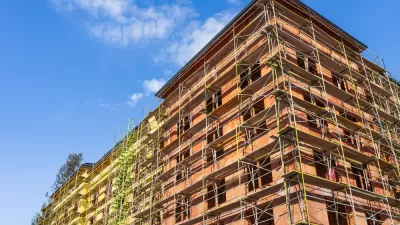A recent study surveyed 800 jurisdictions in 50 U.S. metropolitan areas to quantify the amount of change in zoning regulations throughout the 21st century so far.

Research published in June by the Journal of the American Planning Association examined zoning changes in major U.S. metropolitan areas from 2003 to 2019, finding that zoning grew more accommodating to apartments in strong-market metro areas over that time period.
In addition to the abstract, which is available online, the researchers—Rolf Pendall, Lydia Lo, and Jake Wehmann—provide this "takeaway for practice":
Local land use planners in the United States have ethical and legal obligations to undo the racial segregation designed into zoning from its founding. They also must prepare for continued population growth. Tools and strategies exist to do both of these, and some planners have the commitment and political space to use them. In other places, planners and their professional organizations need to change rules within their own communities and advocate for state legislative reforms so that planning works predictably to unwind unequal and exclusionary settlement patterns within neighborhoods and cities.
The study's abstract suggests that the findings function as a counter-narrative to opinions of pundits and economists that zoning explains housing price inflation in fast-growth metro areas. This research shows the limitation fo the narrative, according to the authors.
For more of the ongoing debate about zoning's role in the housing market, and attempts by local jurisdiction to create more affordable housing supply by loosening zoning restrictions on multi-family housing, see the collection of articles flied under Planetizen's Zoning Reform tag.
The article's abstract and a link to the (paywalled) study is available below. To access some of the research without a paywall, see also a follow up brief built on the original study, recently published by the Urban Institute and written by Patrick Spauster, Lydia Lo, and Yonah Freemark.
FULL STORY: Shifts Toward the Extremes

Manufactured Crisis: Losing the Nation’s Largest Source of Unsubsidized Affordable Housing
Manufactured housing communities have long been an affordable housing option for millions of people living in the U.S., but that affordability is disappearing rapidly. How did we get here?

Americans May Be Stuck — But Why?
Americans are moving a lot less than they once did, and that is a problem. While Yoni Applebaum, in his highly-publicized article Stuck, gets the reasons badly wrong, it's still important to ask: why are we moving so much less than before?

Using Old Oil and Gas Wells for Green Energy Storage
Penn State researchers have found that repurposing abandoned oil and gas wells for geothermal-assisted compressed-air energy storage can boost efficiency, reduce environmental risks, and support clean energy and job transitions.

Updating LA’s Tree Rules Could Bring More Shade to Underserved Neighborhoods
A new USC study finds that relaxing Los Angeles’ outdated tree planting guidelines could significantly expand urban tree canopy and reduce shade disparities in lower-income neighborhoods, though infrastructure investments are also needed.

California's Canal Solar Projects Aim to Conserve Resources and Expand Clean Energy
California’s Project Nexus has begun generating electricity from solar panels installed over irrigation canals, with researchers and state agencies exploring statewide expansion to conserve water and boost clean energy production.

HHS Staff Cuts Gut Energy Assistance Program
The full staff of a federal program that distributes heating and cooling assistance for low-income families was laid off, jeopardizing the program’s operations.
Urban Design for Planners 1: Software Tools
This six-course series explores essential urban design concepts using open source software and equips planners with the tools they need to participate fully in the urban design process.
Planning for Universal Design
Learn the tools for implementing Universal Design in planning regulations.
Heyer Gruel & Associates PA
City of Moreno Valley
Institute for Housing and Urban Development Studies (IHS)
City of Grandview
Harvard GSD Executive Education
Salt Lake City
NYU Wagner Graduate School of Public Service
City of Cambridge, Maryland





























